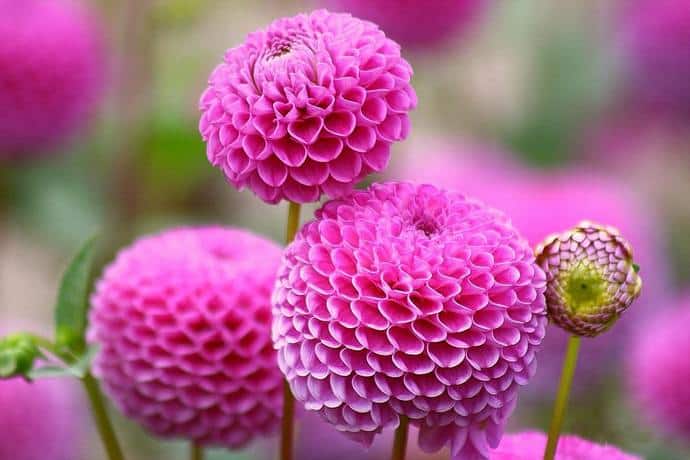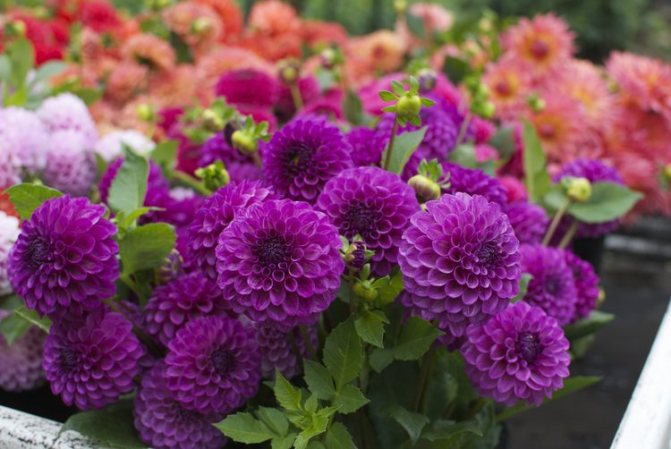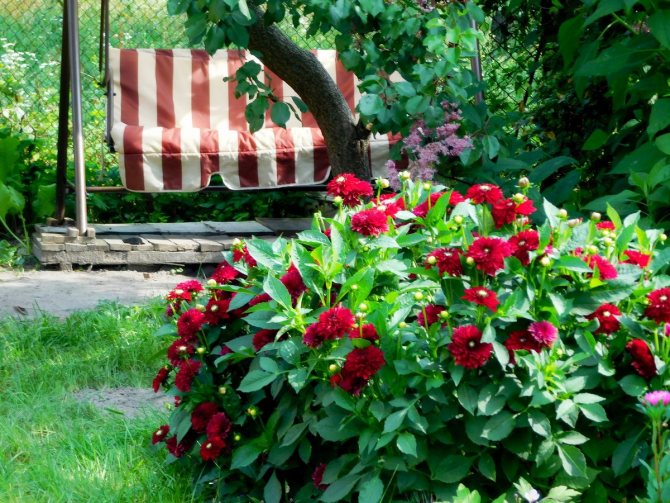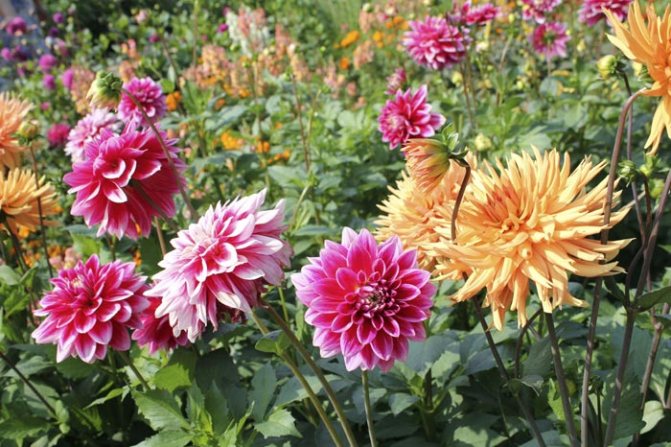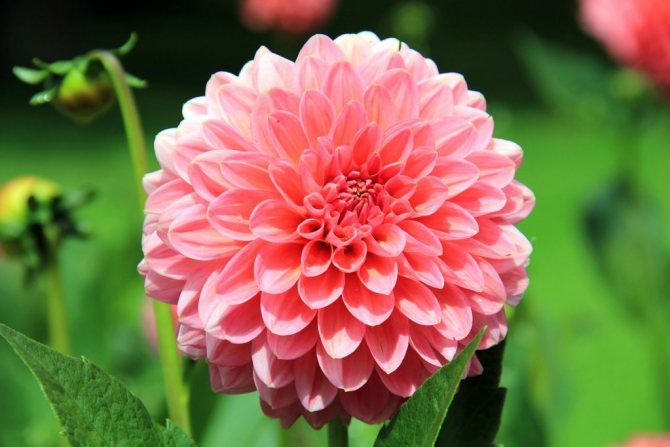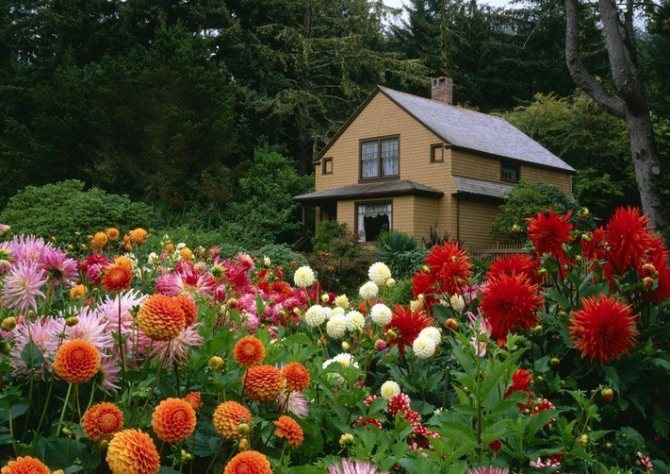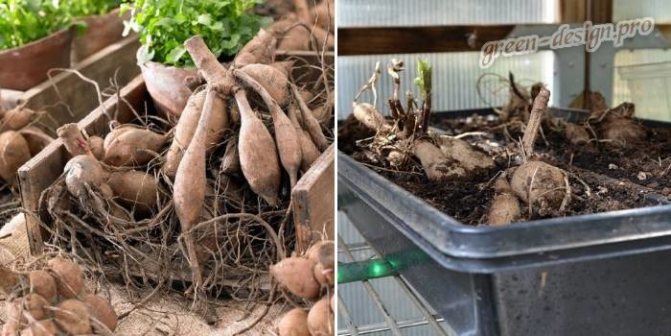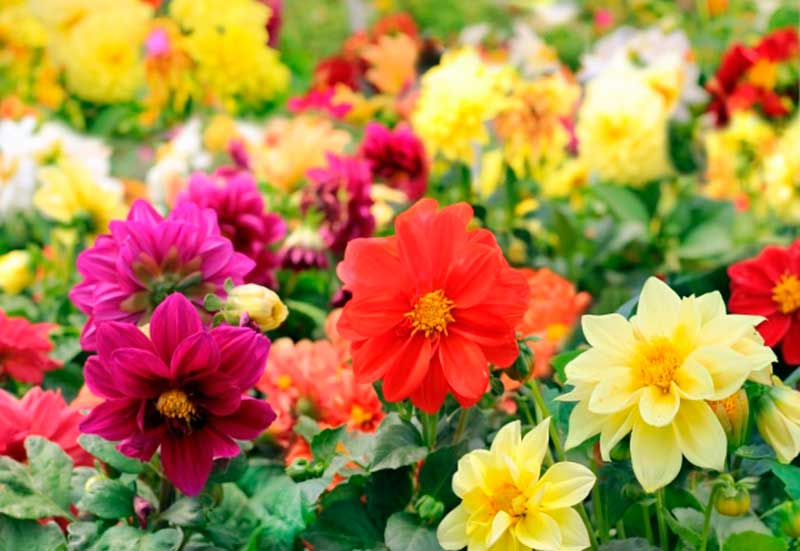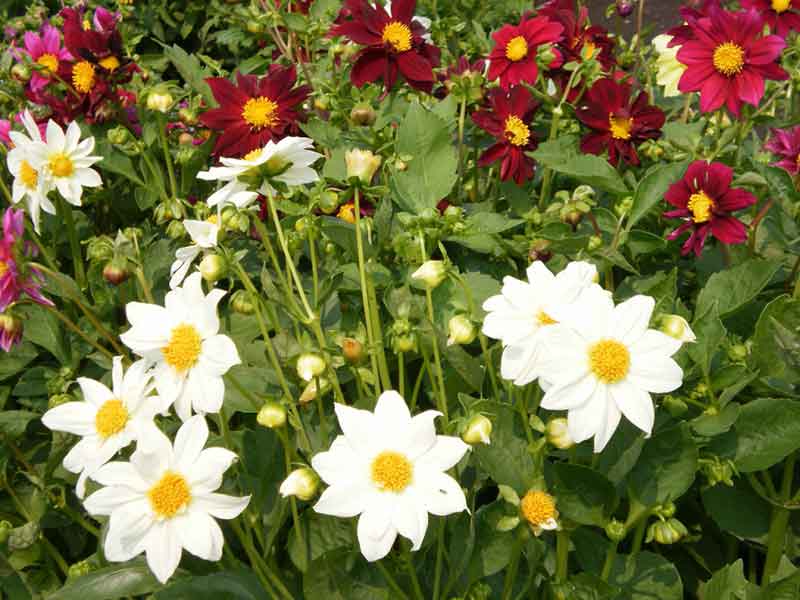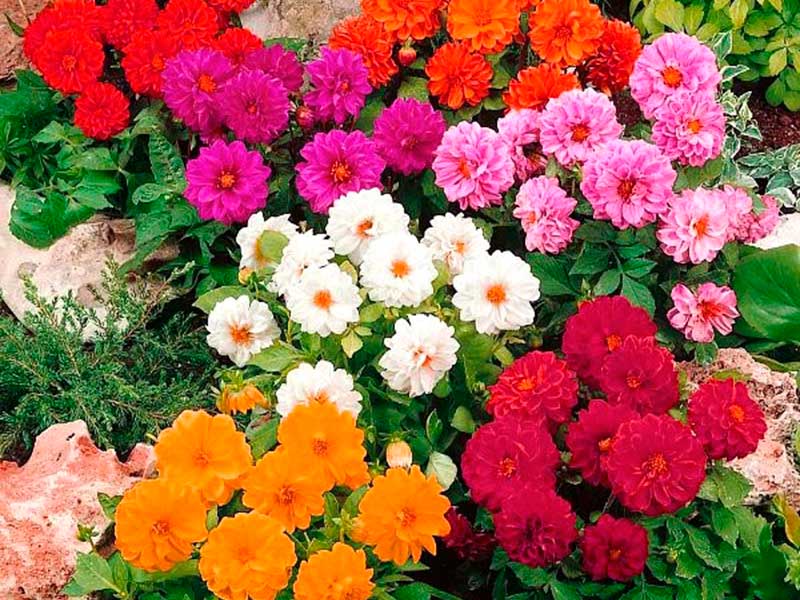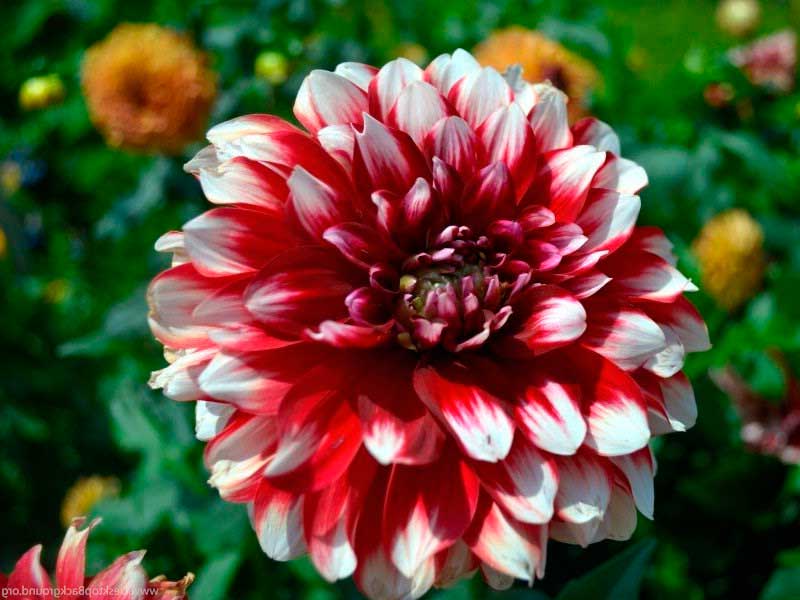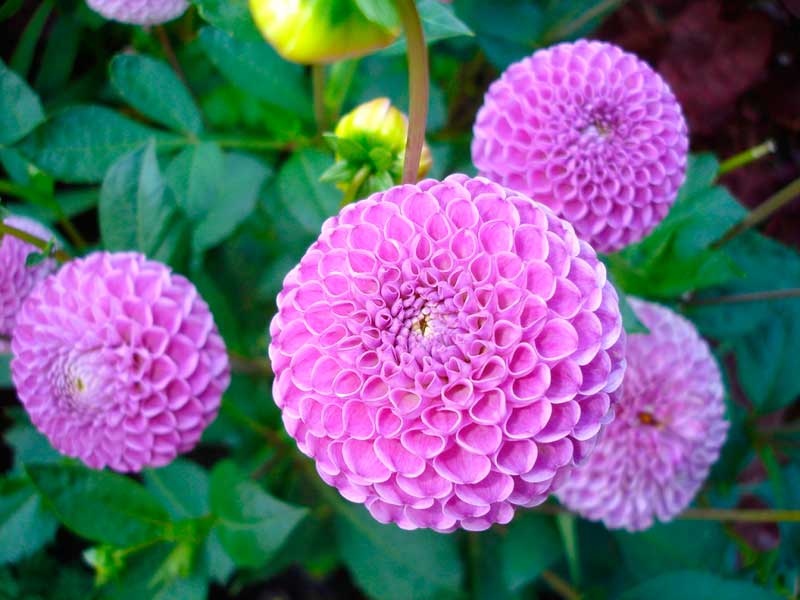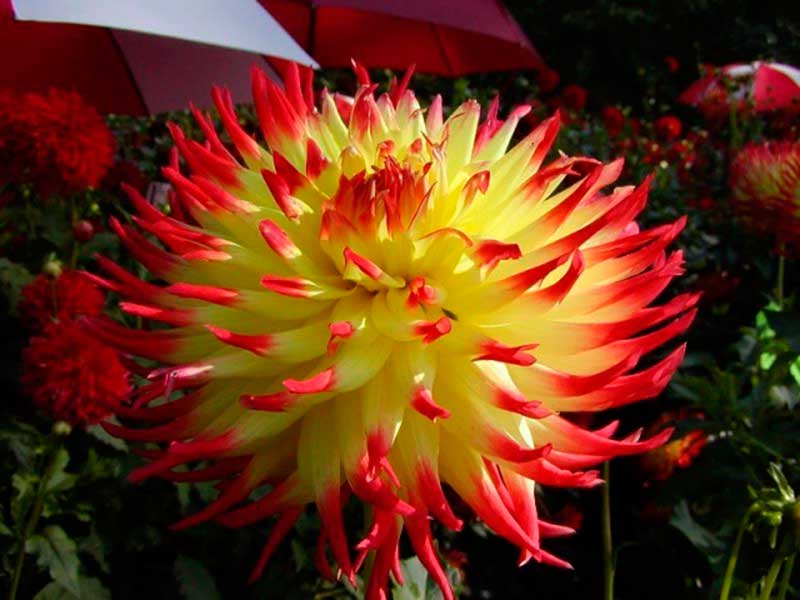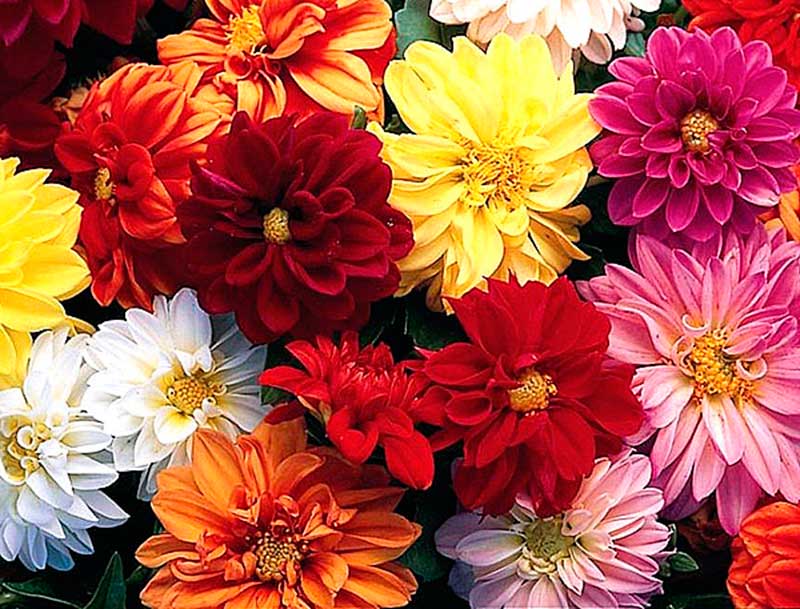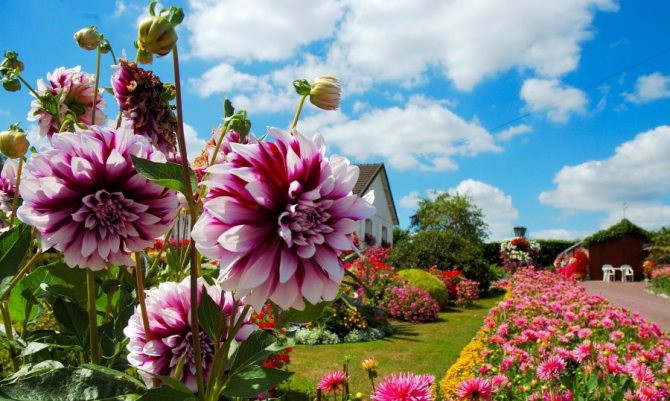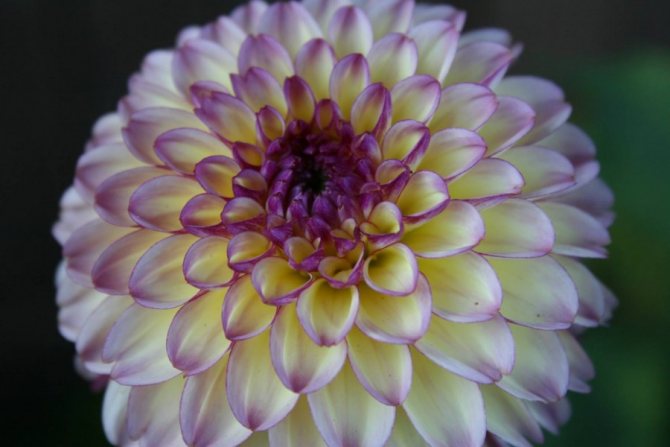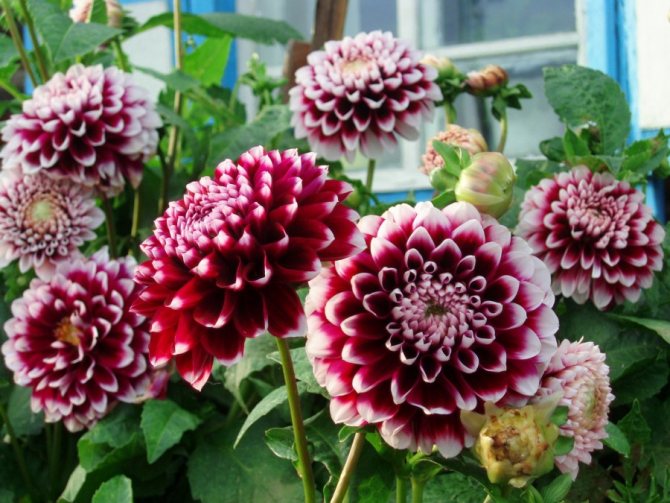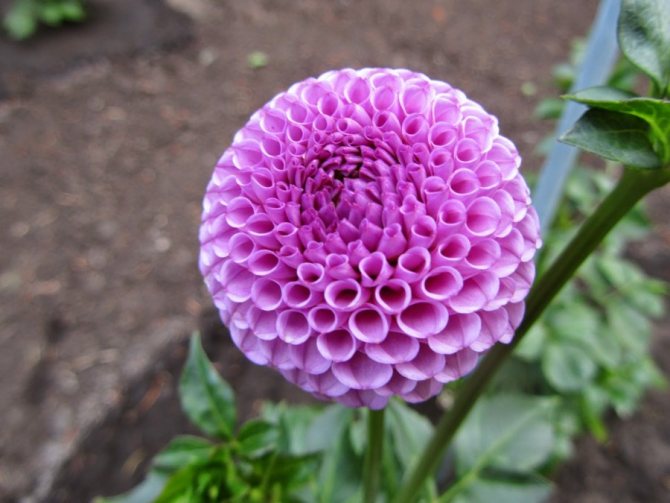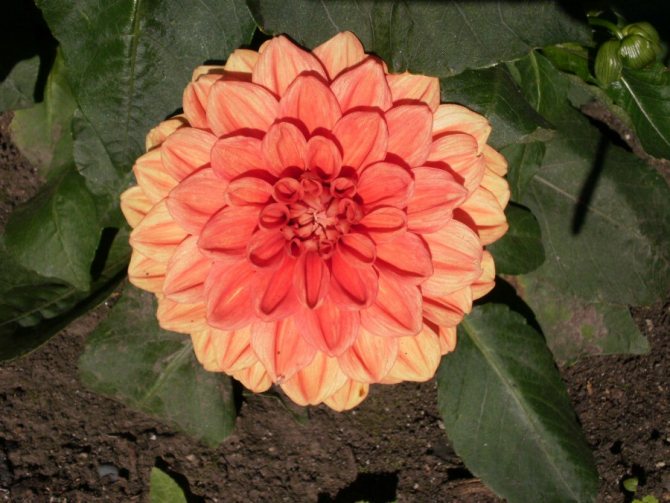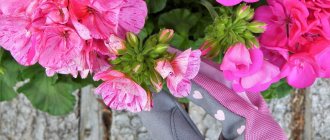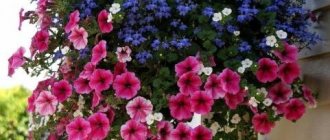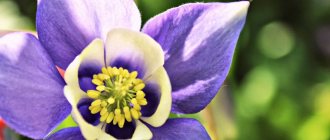Where is it better to plant perennial dahlias
Choosing a planting site is essential to the successful cultivation of dahlias. To get beautifully flowering plants, it is better to plant dahlias in a sunny, draft-free place. Dahlias planted in the shade stretch out and bloom poorly.
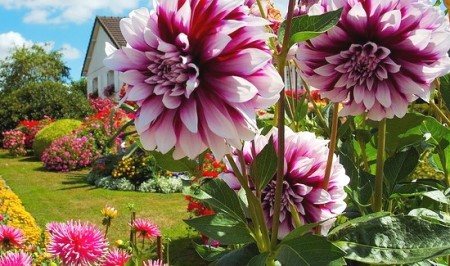
Perennial dahlias
Since tubers with an excess of moisture are prone to decay, the planting site should not be in a lowland where moisture can stagnate. It is undesirable to grow dahlias in one place for more than two years in order to avoid damage to flowers by diseases and pests.
Pre-planting preparation of beds
Soil preparation is carried out in autumn and spring just before planting tubers or seedlings. The soil should be loose, air and water permeable, slightly acidic or with neutral acidity.
In autumn, apply organic fertilizers to the soil: rotted manure - 3-5 kg per 1 sq. M or bird droppings in the amount of 100 g per 1 sq. M. You can add humus, compost. If the soil is heavy, clayey, the addition of coarse sand and ash will help improve the structure. Dig up the beds to a depth of 30-35 cm. The width of the beds is about 1 m, the length is arbitrary.
In early spring, rake the beds to retain moisture in the soil. And just before planting dahlias, dig up the ground with a pitchfork or process it with a flat cutter to a depth of 5 cm. This is necessary to clear the beds from sprouted weeds and roots of sow thistle, wheatgrass, bindweed.
Description
Dahlias of different colors really become a real decoration of the garden. This spectacular plant has about 40 species. They belong to the Astrov family. But in garden conditions, only one species is grown - the changeable dahlia. It has many hybrids and subspecies. There are several thousand of them.
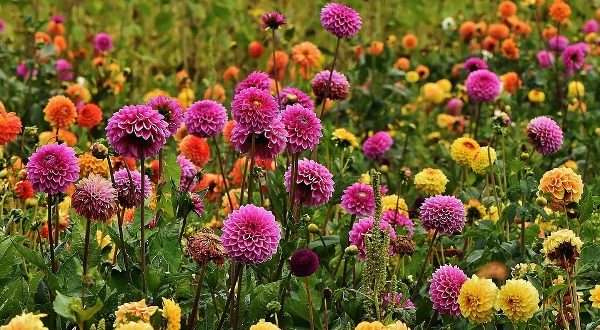

A feature of this plant is the arrangement of the petals in the inflorescence. In the center, groups of beautiful modified stamens (staminodes) are often formed. The petals at the edges and in the middle of the inflorescence can have different shapes.
This plant has a long flowering period, making it one of the best choices for your backyard. This period lasts from July to the end of September. At the same time, the flowering of dahlias is abundant. Up to 10 large inflorescences appear on each plant. Considering what a dahlia looks like, one cannot fail to note its spectacular flowers. In some varieties, their size reaches 35 cm in diameter. They are held on a sturdy hollow stem that does not need additional support.
Dahlia leaves are colored dark green. They have a pinnate shape. The leaves are quite dense. They favorably set off bright inflorescences, creating a spectacular contrast.
The stems usually have one large and several small flowers. They gradually replace each other, which ensures such a long flowering period. Considering what a dahlia looks like, one cannot help but be surprised at their grace, brightness of shades. It is a perennial plant. But it cannot survive the winter in the harsh climate of our country. Therefore, their tubers must be dug out at the end of the season and stored in a warm room until spring. Or you can do it even easier. Every year, just sow seeds in your area. In this case, the plant will be annual.
Dahlia varieties
There are more than 40 plant varieties, but the most popular are:
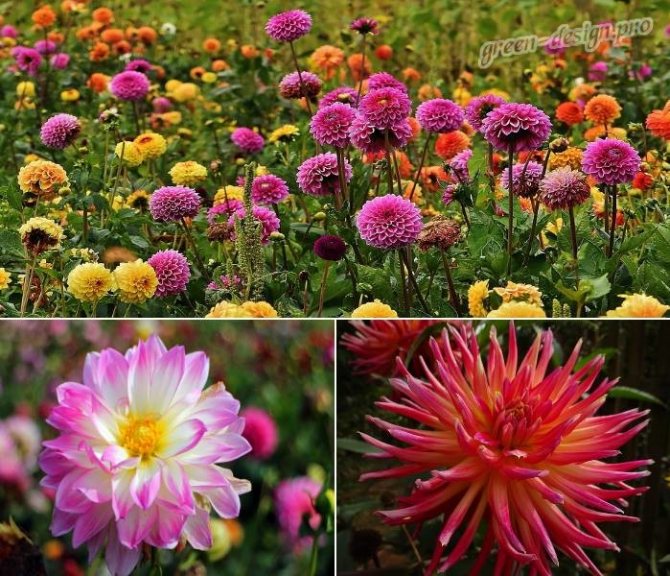

- Needle-like. They have thin petals twisted into a tube, they resemble thin needles, hence the name.
- Spherical. They are distinguished by lush round inflorescences. The petals are large, fleshy. Inflorescences are loose, soft.
- Anemonic. The petals of short graceful tubes are flat along the perimeter.
Varietal variety
Dahlias are classified according to various characteristics. One of the most popular is the grouping by the shape of the inflorescences.


According to this type of classification, 10 classes of these garden plants are distinguished. We will consider the main varieties of dahlia flowers in more detail below. They have certain characteristics that must be taken into account in the growing process.
One of the most common classes are simple dahlias. They have one row of petals. The inflorescences appear fully open and flat. They reach a size up to 10 cm in diameter. Modified stamens are usually located in the center. This class includes tall, medium and dwarf plants.
The class of anemic dahlias is distinguished by double petals. They are located in the inflorescence in several rows, but most often there are no more than three of them. In the center are staminodes. This group of plants can have petals of various shades. They range from bright white and yellow dahlias to pale pink blossoms. They have a size of 5-10 cm. Their core is always yellow. The stems are 60-120 cm long.
The peony class represents large flowers of the double or semi-double type. In the center are relatively low staminodes. The petals are predominantly three-rowed. As they approach the center, they decrease. But there are also very dense inflorescences. The number of their rows reaches 10 pieces. Flowers are large in size, which can reach 20 cm in diameter. This is a tall class that stretches up to 80-130 cm.
The collar class is distinguished by a special structure of the inflorescence. The inner petals are short. This is typical for all representatives of this group. They are framed by outer long petals. Two rows create a collar effect. They have different colors. The average size of inflorescences usually does not exceed 10 cm.The bushes reach a height of 70 cm.
A few more classes
Which dahlia flower to choose for planting in your garden depends on your taste preferences. But many owners of private houses agree that representatives of the globular class are one of the most spectacular varieties of this plant. They differ in the corresponding shape of the inflorescences. They may be slightly flattened. But there are also dahlias that have an almost perfect ball shape. They have rather heavy inflorescences. Their size varies from 7 to 20 cm. The size of the bush can also vary significantly, depending on the variety. Mostly their inflorescences are red, but can range from delicate pink to purple.
Another popular variety is pompom dahlias. They are similar to the previous class, but their shape is more flattened. There are also some differences in the shape of the petals. Their color is usually gradient, often consisting of three different shades. Usually their inflorescences are small (on average 8 cm). But the stems can be up to 120 cm high.
Cactus dahlias look original. These are buds with thick double petals. Their shape is rather unusual, resembling the needles of a cactus or hedgehog, which has curled up into a ball. There are varieties in this class, the buds of which have up to 6 different shades. These are very beautiful dahlias. These are the largest buds, reaching a diameter of 35 cm. Their sturdy stems reach a height of 2 m. This is one of the most popular classes.
The semi-cactus class is worth considering as one of the best options when choosing flowers in the garden. Dahlias of this subspecies have some petals (usually external) of a cactus shape, while others are similar to another variety. These inflorescences are inferior in size to the previous group. But at the same time, they are still quite large. Inflorescences have a diameter of 8 to 30 cm, depending on the variety. Moreover, plants of this class are usually tall. Some of them are capable of reaching a height of 2 m. But there are also dwarf varieties (up to 30 cm).


Very graceful flowers belong to the nymphae class. They have terry petals that are large in area. The buds are a bit like a lotus. They reach 7-18 cm in diameter. The stems can grow up to 70-140 cm in height. The colors can be varied. But almost always there is white in it. Many varieties have radial symmetry.
Decorative dahlias have a specific, specially derived feature. This can be the shape of the petals or the shade of the modified stamens, etc. Most often these are hybrids that have high survival rates. These are very beautiful plants. They have medium to large buds 12-25 cm in size and stems 100-150 cm high. Their leaves and stems are darker than those of other subspecies.
Dahlias perennial species, main groups and varieties
Dahlia belongs to garden dwellers who have a very complex classification system. Thanks to the work of breeders, at the moment there are over 15 thousand varieties of these wonderful perennials, based on the botanical form of the cultivated dahlia (changeable). According to the height of the bush, the following types of zhorzhina are distinguished:
- dwarf - up to 0.6 m;
- undersized - 0.6-0.8 m;
- medium height - 0.8-1.2 m;
- tall - 1.2-1.5 m;
- giant - over 1.5 m.
Botanists subdivide exotics into 11 main groups, the classification is based on the structure of the baskets. Every year, a lot of new cultivars appear and new groups develop.
Attention! Varieties belonging to a certain group differ only in the color of the petals and the size of the heads.
Consider the main characteristics of the varieties selected by the breeders and the best hybrids of a particular group. Simple (single-row) dahlia have non-double heads, consisting of one row of reed flowers. Wide petals form flat corollas 4-10 cm in diameter. The fruiting center is yellow. This cultivar is made up of very unpretentious specimens up to 60 cm high. The ability to easily endure drought or heavy rains without losing its decorative effect made simple georges the favorites of gardeners.
The best varieties are pink-orange Happy Single Flame, dark yellow Yellow Hammer, burgundy Agnes, carmine Romeo, orange Happy Kiss. The colors of the petals of these cultivars are very diverse, the middle is yellow, and the growth does not exceed half a meter.


The next group is called anemic because of the similarity of the heads with terry varieties of anemone. The middle of the buds is painted in yellow tones, along the edge there are 1-3 rows of elongated petals of various colors, forming a semi-double basket 4-9 cm in diameter. Tubular flowers are larger, elongated along the edge of the yellow middle. The height of the anemic group is 60-90 cm.
The most popular varieties are: pink with a yellow middle Hani, purple Peple Hayes, pale pink Lambada, pink with burgundy irregular stripes of Boogie Woogie, white Toto, deep pink Mambo, cream with pink edging Polka, maroon Jive.
Know! Anemous and simple varieties are great for growing in flower pots, balcony boxes.
The collar group also belongs to non-double varieties. It is represented by medium-sized cultivars 75-120 cm high. The heads look very impressive due to the two rows of petals.The outer ligulate flowers are twice as large as those adjacent to the middle. Their color differs by several tones, so the baskets look very decorative. The size of the buds is 5-10 cm. Representatives of collar dalias are suitable for decorating borders, they are excellent in cutting.
Popular hybrids: Night Butterly with long burgundy and short white petals; La Gioconda yellow short and scarlet long petals; Impression with bright crimson long and crimson white short; A first grader with long petals of a pale pink shade and white short ones.


The nymphaean group is represented by lotus-like hybrids of average height 0.7-1.2 m. They are characterized by closed hearts and 4 rows of fully open reed flowers of regular shape. Lush heads with a diameter of 5-20 cm are directed upwards, ideal for cutting or a bright accent in the garden. The name was given for the similarity of the corollas with the water lily of the nymphea. The best varieties are recognized - golden Leo Jelito; bright scarlet Barbarossa; pink angora; orange Kens Flame; pink or peach Moray Susan.
On a note! Lotus-shaped cultivars are grown mainly for cutting. Therefore, you should responsibly treat the formation of a bush in order to get lush heads.
The globular group includes medium-sized cultivars (70-120 cm), which stand out among their fellows by very abundant and long flowering. Baskets 10-15 cm in diameter consist of folded petals of the same length at the base. They form dense terry balls, slightly flattened in shape.
The best hybrids are Genova pale pink with darker edges; Evelyn is white with light purple edging; Sandra deep pink; Edinburgh is burgundy with white tops; Golden Torch (golden torch) with golden heads; Maarn with beautiful peach corollas.
Pompom or pompom dalias are almost complete copies of their spherical congeners. The only difference is the diameter of the head, which is only 4-9 cm. In this case, the hybrids belong to tall 100-130 cm, require obligatory support for fragile stems. Cut these wonderful balls keep fresh for up to 2 weeks.
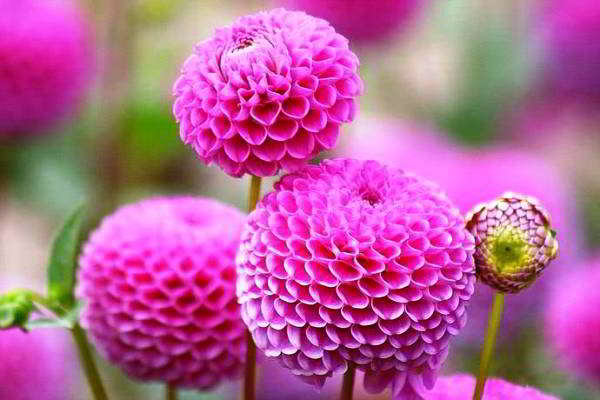

Popular cultivars: Sunny Boy yellow with orange tips; pink-orange Buntling; An acrobat with lower white petals, which become a deep pink hue closer to the core; intense crimson Rocco; scarlet Glow; snow-white Snowflake.
Take on arms! Having decided to grow bright pom-poms on a flower bed, you can make a magnificent autumn bouquet for schoolchildren.
Dahlia peony is not very popular with gardeners. The average height of the representatives of the group is 0.6-1.0 m, the heads are large up to 20 cm. The yellow pillow is surrounded by fully unfolded ligulate flowers in the amount of 3-4 rows. Several varieties have nevertheless won the love of gardeners - the red-orange Heart of Danko, bright yellow with a burgundy middle Chic, peach Symphony, pale pink Charm.
The cactus cultivar is otherwise called needle-like. It includes tall (1-1.5 m) hybrids with double baskets consisting of reed flowers rolled into tubes. They diverge in all directions from the center of the bud, forming a lush inflorescence with a diameter of 15 to 25 cm. This group is very popular with gardeners. Best hybrids:
- Omega. Peach corollas up to 20 cm in diameter with split edges.
- Black Wizard. A very interesting hybrid with burgundy edges and an almost black center. Corolla 15-18 cm.
- Klondike. Snow-white giant 140-160 cm tall with large needle-like corollas up to 20 cm in diameter.
- May Love. A cultivar about a meter tall with dense double inflorescences of a snow-white shade with a diameter of 18-20 cm.
- Florida. The golden-yellow inflorescences are deeply dissected along the edges, which makes them seem somewhat disheveled. Size 15-18 cm.
- Park Record. On low bushes up to 0.5 m in height, lush large baskets of a bright orange hue open up.The edges of the petals are heavily cut.
- Stars Lady. Dwarf cultivar up to half a meter in height with small pinkish-white buds 10-14 cm in diameter.
- Tahiti Sunrise. Pinkish-yellow inflorescences with rich burgundy tips. Bush 60-80 cm, buds 10-15 cm.
- Ambition. On the pink-lilac needles, there are specks and a flat lilac shade. The bushes stretch out to 100 cm, and the buds are about 10-12 cm.
- Helga. Coral needles are collected in a lush inflorescence with a diameter of 12-15 cm.
- Aloha. Ideal for cutting. Yellow needles turn reddish-orange from the middle. On bushes 120-140 cm high, up to 10 buds 15 cm in size simultaneously bloom.
Know! A long period of decorativeness, unpretentiousness and colorful appearance make it possible to use the cactus variety type very widely. They are grown for cutting, decorating mixborders, prefabricated flower beds, planting along curbs.
Semi-cactus georges are similar to their needle-like relatives. The only difference is that the lower half is wide, open, and the upper part of the petals is rolled up into a tube. They are no less popular with gardeners and landscape designers. The best hybrids are peach or orange Vulcan, cherry Cherio, Jax Pride, snow-white Ice Princess, white with pale pink tips Magic Moment, yellow with pink tips Shooting Star.
The largest cultivar group is decorative. It includes tall hybrids with large buds. The corolla is terry (10-25 cm) with flat petals bent towards the peduncle. It stands out with completely terry inflorescences of extraordinary beauty. The decorative qualities of the representatives of the decorative variety group are highly appreciated by specialists.
There are a lot of decorative hybrids, every gardener will be able to choose a specimen to his taste. We recommend that you pay attention to these hybrids: Arabian Night, Times Valley, Giocondo, Duet, Bonaventure, Zorro, Contrast, Lavender Perfection, Melody Dixie, Rebeccas World, Painted Lady, Peach and Cream, Red Empire, Phantom, Tyler James.
The last group is called mixed. It is the smallest in number, since it includes rare cultivars that do not fit the description for the considered varieties. This includes orchid or star-shaped types of inflorescences. The height of the plants is from 40 cm to 2 m, the buds are 6-25 cm in diameter. The colors are very diverse. Examples of hybrids are Akita, Pink Giraffe, Honka, Flame and Ice.
Important! Despite this diversity, perennials have almost the same agricultural techniques. The nuances are so insignificant (for example, tying tall species to a support) that even a beginner can cope with the cultivation of a colorful culture.
Growing features
Dahlias, yellow, red, pink or multicolor, can be planted on your site in different combinations. It's pretty easy to grow them. But leaving can take some knowledge and time.
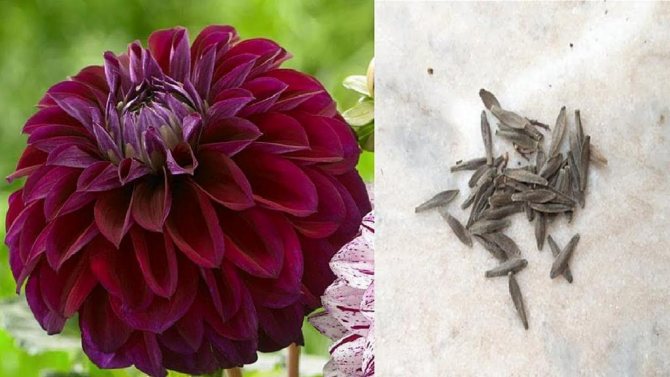

Perennial dahlia flowers, planting and caring for which must be carried out according to a specific system, are usually planted after choosing a suitable variety. To do this, you can experiment by planting annual plants on the site. If you realize that this variety, grown from seeds, you want to see on your site for more than one year, dig up its tubers in the fall. In the spring, you plant them in the ground to decorate the site with your favorite flowers.
If you don't want to put some effort into growing these flowers, use seeds. They are sown in the ground no earlier than the second half of May. They will bloom in late summer. If you want to see beautiful buds in your flower beds earlier, you need to grow them in a greenhouse method.
To do this, prepare a plastic container or other suitable container. They must be clean. The container is filled with calcined sand. The seeds of this plant are laid out on its surface. Then they need to be sprinkled with a thin layer of sand.Using a spray bottle, the surface is carefully moistened. The greenhouse is covered with a transparent film.
The germination process takes approximately 1.5 weeks. In this case, the temperature should be about 26 ° C. When sprouts appear, they will need to be dived. A small container is prepared for each of them. The soil should be loose and absorb water well. It can be purchased at a flower shop.
3 days before the dive, the ground must be properly prepared. To do this, it is impregnated with a solution of potassium permanganate. It should be around 70 ° C. You need to achieve a dark pink color. Plants transplanted into separate containers are watered as the soil dries out. In mid-May, seedlings are planted on the site.
How to plant and care
The unpretentiousness of annual dahlias, affordability and exceptional decorativeness have made them very popular among flower lovers, both beginners and venerable. These cute flowers are planted with seeds, seedlings at home, sometimes they save nodules for the winter (it is not recommended to do this for more than 2 years in a row due to the degeneration of varietal traits).
It is recommended to buy seeds in special stores, preferring trusted or well-known manufacturers. It often happens that other (more often simpler) dahlia seeds are put in a bag.
Seeds in the ground on the street
Sow annual dahlias directly into the street in the spring. Make sure that the earth warms up and dries up. Do not bother throwing seeds into icy soil, such haste will not lead to anything good. At best, they will rise later, at worst, they will rot.
Optimal term - the beginning (if it is already warm) or mid-May (Ural, Volga region, middle zone). The flowering of annuals with this method of planting is postponed to the end of July, the beginning of August, these autumn colors so enliven the space!
- We choose a sunny, open place for these flowers.
- The soil is needed loose, loamy or slightly acidic.
- We apply fertilizer during digging, whatever we can find - this is wood ash, humus or compost, superphosphate.
- We level and mark the garden: the distance between plants is 25-30 cm (low varieties) and 50-70 cm (high varieties).
Put dahlia seeds in shallow (2-2.5 cm) grooves, water and sprinkle with humus or peat mulch. This does not form a crust on the soil, and the shoots will appear faster. The seeds germinate together, and also easily tolerate a transplant if they sprout up densely.
Advice! Do not be afraid to plant weaker seedlings elsewhere, they will take root well and form strong plants.
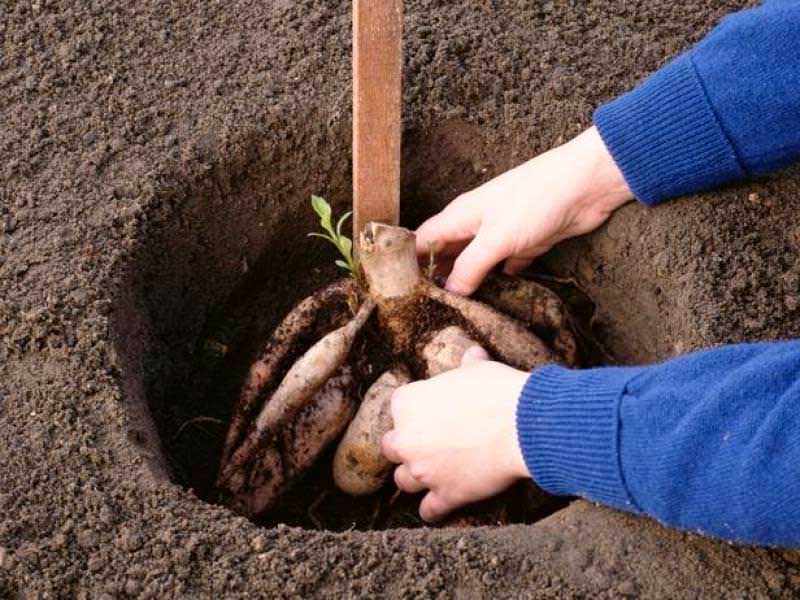

Seedling method
We warn novice gardeners who are going to sow dahlias for seedlings too early, for example, in March (you can find such recommendations on the Internet). Your seedlings will elongate, thin out, and will fall when planted in the ground. There is only one way out of this situation - to pinch the top.
Since it takes about 55-60 days from germination to the appearance of a flower, you need to plant seedlings at home in early or mid-April. Flowering will then begin in June and will continue until autumn.
The seedling method is good for the middle lane and more northern, as well as Siberian regions. When planted in this way, annual flowers will bloom earlier than those sown directly in the spring garden.
- We prepare containers or individual cups, pour special soil or garden soil there.
- We make depressions of 1-1.5 cm and spread the seeds, sprinkle with earth.
- Pour from a spray bottle, cover with foil (and germinate without it).
- After a few days, sprouts will hatch, the film can be removed.
Dahlia seedlings are planted outside in warm ground, even if the seedlings have grown by only 5-7 centimeters. The distance between plants is the same as when planting seeds directly into the ground (described above).
Seat selection
You need to find the right place to plant your plants. It depends on how bright and beautiful your flower beds will be.You also need to know when to plant dahlia flowers. It depends on the characteristics of the climate. Usually this procedure is carried out in May. But if it is usually cool in your region even during this period, postpone this procedure until early June. Residents of warm regions can do this work in early May.
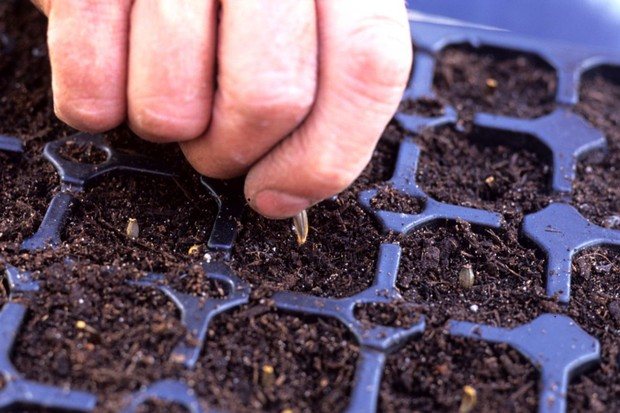

How to plant dahlia flowers? Pay attention to choosing the right place for this process. Dahlias should not grow in a draft. Here they will develop poorly and get sick. Therefore, consider the right hiding place for them. It should be sunny enough in here.
The soil should be well-drained and contain nutrients. Loose soil is needed, which could pass water well. The acidity level is not particularly important. But the optimal level is considered to be from 5 to 8 pH.
In the fall, even before planting the plant, the soil on the site needs to be dug up. Compost and humus are added to it. In the spring, before planting, a small amount of wood ash is spread over the surface. You also need to add non-deciduous compost to the ground, which needs to be hardened with a rake. It is best to plant the plants in a new area each time. The place where they grew last year should rest for 3 years. Also, asters or flowers that had fungal infections should not have grown here.
Tuber preparation
The dahlia flower must be properly prepared for planting. If tubers are used, you need to properly prepare them for the upcoming season. This process starts back in April. It is necessary to remove dried roots or other defects from the tubers. Zelenka process the places of the cuts.
Then the tubers are planted in a pot. It needs to be filled with fertile soil. Peat is also good. The upper part should rise above the surface by 2-3 cm. Then you need to put the container in a warm, lighted place. It should be at least 18 ° C here.


When the kidneys appear. At this point, the tubers are divided into separate parts. Each of them should have a root collar and one bud. Sometimes up to 5 parts are obtained from one tuber. They are again planted in separate containers for a while. Lateral shoots must be cut off if their height is at least 10 cm. Then they are planted on the site.
Dahlia flower can also be grown by cuttings. Cut off shoots should be planted in nutritious soil and removed in a darkened place. They need to be watered well. The cuttings will take root over time. After that, you need to transplant them into open ground. This approach allows you to propagate the plant quickly, planting it throughout the site. Your flower beds will be gorgeous.
Landing in the ground
It is necessary to properly plant dahlia flowers in the ground. Planting and grooming must be done correctly. In this case, your flower beds will be gorgeous. When the weather becomes warm, and the probability of frost is minimal, you can start planting plants on the site.
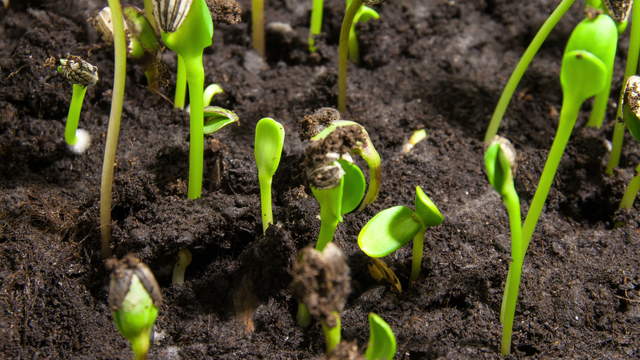

The hole should be 3 times larger than the root tuber. Around it, inside the recess, another 5-7 cm should remain. At the bottom, you need to lay out a layer of manure or compost. Pour some soil on top. Then place the tuber on the bottom. It is sprinkled with earth, but its stem should be above the surface.
After that, the plant is watered abundantly with water. The soil is mulched to prevent rapid evaporation of moisture. For this, sawdust is used. They are mixed with peat or compost. The soil around the plant is covered with mulch with a layer of about 5 cm.
Dahlia planting tips
I am happy to share with readers tips for growing my favorite dahlia beauties. I split dahlia tubers about seven days before planting. And I plant it when there is no longer a threat of frost in our Don region. About a week before that, sprouts the size of a half or little finger should appear on the tubers (this depends on the size of the tuber).
When there are several varieties, I carefully, trying not to scratch the surface, write their names directly on the tuber with a soft simple pencil, carefully cleaning it from the remnants of the earth. I spread the tubers to the light, spreading them out on a substrate of wet peat or raw sawdust. There can be two or three sprouts on a tuber; in the light they quickly turn green and get stronger.
Three days later I spray them with water (or maybe a weak solution of some kind of fungicide) and after another three or four days "dahlia" can be planted in a street flower garden. If there are at least two tubers in the cut, the plant will bloom in the same year. Thanks to cuttings for the new season, you can get a large amount of planting material, as well as rejuvenate old plants.
Perennial dahlias cut well
To do this, I remove the sprouts of tubers with buds that have already turned into sprouts into the light and, when the sprouts turn green (and this can happen in two days), I separate them from the tubers with a sharp knife. After a short drying, I plant such a stalk in a small 150 ml glass and cover it with a transparent bag.
All this should take place in the light.
The sprout separated from the tuber should be at least 5 cm. Such a stalk takes root well and after a week can give roots by itself, without any stimulants. In early summer, I transplant the cutting into the garden. This season it will not bloom, but next season it will.
Care rules
Dahlia flowers require some steps in the care process. A layer of mulch will prevent the soil from drying out quickly. It will also protect the plant from slugs, avoid the need to weed the soil and loosen it.
Water dahlia flowers abundantly 1-2 times a week. But this is on condition that dry weather is established. The soil should not be waterlogged. Rot may appear on the roots of the plant. You can reduce the amount of watering when hilling the plant. First, they carefully rake off the earth, water the flower, and then they spud it back.
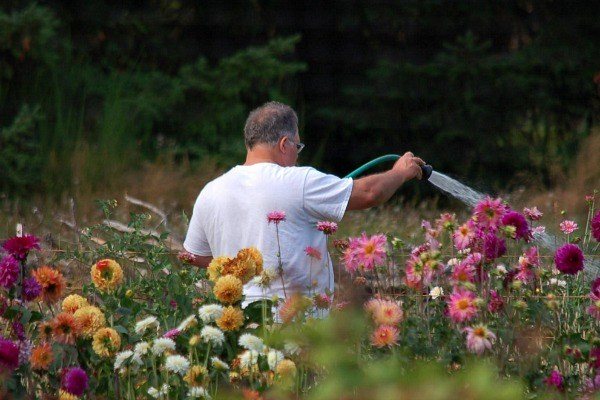

When the growing season comes, you need to make top dressing. This work is done every 2 weeks. For this, both organic and mineral fertilizers are used. They are introduced into the soil one by one. When you notice the first buds on the plant, you need to apply potash fertilizers and superphosphate.
If you are growing tall varieties, you need to provide reliable support for the stems. This is required during bad weather. These flowers have a hollow stem, so they are quite fragile. To keep it from breaking, you need support. If the stem does break, apply a splint on it.
You will need a sturdy branch for this. It is applied to the damaged area. Then it is fixed. The stem will not tilt. Flowers can bloom even on a damaged stem. But this is subject to proper care.
It's also important to pay attention to pruning. In this case, the flowers are large and spectacular. Only 3 stems need to be left. Otherwise, the inflorescences will be small. Excess buds must be removed. Leave no more than 2 flowers on the shoot. As soon as the bud begins to wilt, it is cut off. They take a lot of energy from the plant. In tall varieties, lateral shoots are cut. They are used as cuttings. If the variety is undersized, you can leave these shoots.
Disease and pest control
The plant is most often affected by pests that like to feast on delicious dahlia roots or juicy inflorescences. We are talking about spider mites, aphids, slugs, caterpillars, etc. In order to avoid the spread of pests (when they first appear), dahlia bushes must be treated with a solution of celandine / wormwood once a week.
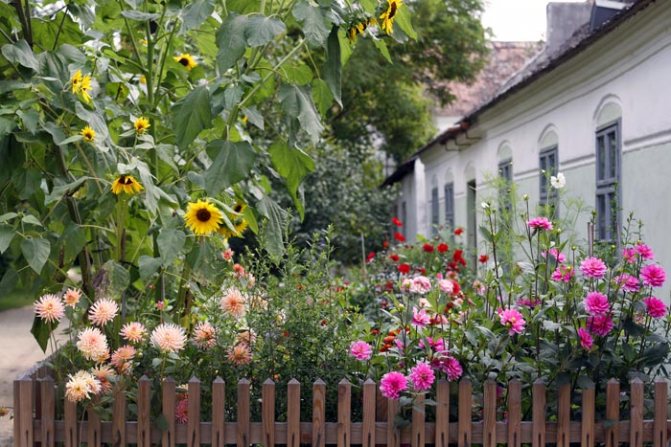

Flower bed with dahlias
Slugs, for example, are very fond of young dahlia stems, so you can protect the plant's bushes by sprinkling the soil around each bush with a slug repellent.
If the plant is sick with spotted / mosaic wilting, unfortunately, nothing can help it: all that remains is to immediately remove the bush from the site and burn it.
Today you got acquainted with the peculiarities of growing and caring for perennial dahlias. As you can see, this process is quite simple, if you follow all the rules and regularly monitor the growth of the plant in the garden. Good luck!
Harvesting tubers
Dahlia flowers, which are grown as a perennial plant, need to be properly prepared for wintering. At the end of the season, when the first frosts come, the tubers are dug up. The stems and leaves are cut from them. Shoots need to be shortened to 7-8 cm.
Some gardeners first cut the stems, and only then dig up the tubers after a few days. This is not the best solution, as it may rain or other moisture gets on the stems. In this case, it is almost guaranteed that the plant will rot in these places. To avoid this, it is best to dig up the tubers first. You can also leave the tubers in the ground, but wrap the cuts with foil.
The necks of the plant are fragile, so care must be taken when digging up the tubers. This is best done in the morning when the weather is dry. By the evening, the neck will dry out. In this case, it will become stronger. When the tubers are dry (at the end of the day), soil residues are removed from them.
To extract the tubers from the ground, they are dug in from four sides. At the same time, 30 cm recede from the stem. So you will cut off the long roots. The pitchfork is gently inserted under the clod of earth. It is pushed to the surface. The soil is removed as much as possible by sprinkling with water from a hose. Lay out the tubers to dry. You need to remove the plants on time. If warming occurs, the kidneys may wake up. This will lead to the death of the plant.
Preparing perennial dahlias for winter storage
Discard tubers with rot or deep passages that go inside: you will never guess who may be sitting in the depths of this passage. Discard single rootless tubers. The likelihood that they will grow again is very small. It is better to dig with a pitchfork so as not to accidentally cut them.
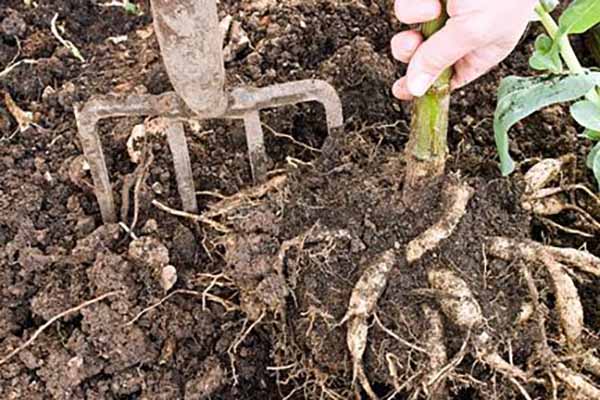

Simply pry the soil with a pitchfork and carefully remove the entire tuberous ball. Shake off dirt particles. Cut off the stem and leaves (they can be sent to the compost heap). Now the tubers need to be dried in the sun during the day. When dry, shake off the dirt again.


You can rub them gently with your hands. Mark the variety or color of the dahlias you dug. For example, tie a string with a plastic or wooden tag to the tubers. The remaining stems of dahlias should be no more than 3 cm so that they do not start to rot in winter.
A large cardboard box is suitable for storing dahlias. Place the tubers in it at a distance from each other to exclude infection. If any of the tubers does start to rot.
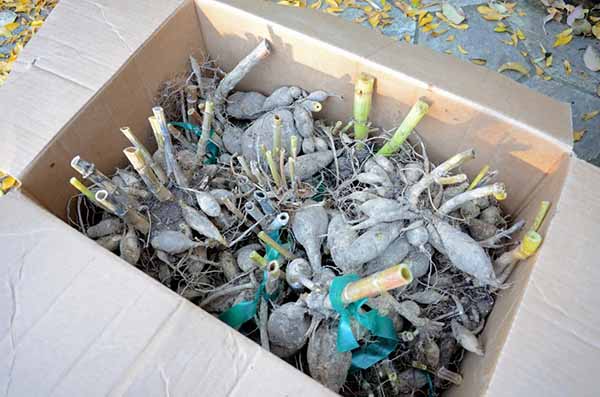

Sprinkle the peat over the tubers. If the box allows, you can add another layer of tubers with peat. Instead of peat, you can use sawdust or feed pellets. The medium used must protect the tubers from drying out and excessive moisture.
That's it - the dahlias are ready for wintering. They should be stored in a cool place where there is no frost (for example, in a caisson or cellar), but many are also stored in the refrigerator, this type of storage takes place, but you always need to understand that modern refrigerators dry the air and this can affect the bulbs.
Storing tubers
Only well-dried tubers can be stored until spring. Otherwise, rot will appear on them. But it is also impossible to dry them out, since their shoots may subsequently be weak.
If there is damage to the tuber, they need to be cut off. These areas are treated with charcoal, and the root collars are sprinkled with chalk or ash for preservation.
The tubers are stored in a ventilated area where the air humidity is between 60% and 70%. In this case, the temperature here should be 3-5 ° C.A dry basement is well suited for these purposes. But keep in mind that if vegetables are stored here, the moisture level will be higher than required. This increases the risk of fungal infections and rot.
The tubers are laid out in boxes, the bottom of which is covered with peat. They also sprinkle the created blanks on top. If they begin to dry out, the substrate is slightly moistened (but not very much). It is desirable that there is ventilation in the basement.
If desired, you can store tubers on the balcony. But they also need to be properly packaged, covering them with substrate. Provide the correct storage conditions. In the spring, you can remove the tubers from the containers and re-plant them in your area.


